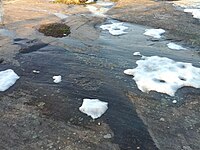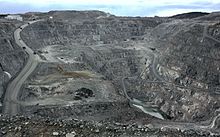Geology of Finland
On top of these lies a widespread thin layer of unconsolidated deposits formed in connection to the Quaternary ice ages, for example eskers, till and marine clay.
[1] Following this last orogeny, rapakivi granites intruded various locations of Finland during the Mesoproterozoic and Neoproterozoic, especially in Åland and in the southeast.
[2][4] With Proterozoic erosion amounting to tens of kilometers,[5] many of the Precambrian rocks seen today in Finland are the "roots" of ancient massifs.
This subdivision, established by Gaál and Gorbachev in 1987, is based on the different geological histories of the domains prior to their final amalgamation 1,800 million years ago.
Studies of detrital zircon show that the sedimentary protolith of the metamorphic rocks of the belt could not be more than 2900–1940 million years old.
[18] Granitoids that intruded in the aftermath of the Svercofennian orogeny are common in southern Finland occurring mostly within ca.
[18][19] These so-called Lateorogenic granites are distinguished by usually containing garnet and cordierite and being accompanied by rather few rocks of mafic and intermediate composition.
Formed 1810–1770 million years ago, these are the youngest granitoids in southern Finland associated with the Svecofennian orogeny.
[21] In Finland, Jotnian sediments occur in the Muhos Graben near Oulu at the northeastern end of the Gulf of Bothnia[23][21] and further south near the coast at Satakunta.
[23][24] Jotnian rocks are also found offshore between Finland and Sweden in the Gulf of Bothnia and the Åland Sea including South Kvarken.
[31][30] The Kola Alkaline Province is commonly presumed to represent an igneous hotspot created by a mantle plume.
[32] Carbonatites in Finland have wide range in ages but they all derive from a "well-mixed" portion of the upper mantle.
[33] The youngest rocks in Finland are those found near Kilpisjärvi in Enontekiö (the northwesternmost part of the country's northwestern arm).
[39][A] By some estimates, the Quaternary glaciers eroded away on average 25 m of rock in Finland,[2] with the degree of erosion being highly variable.
[42] Northwest to southeast movement of the ice has left a field of aligned drumlins in central Lapland.
[42] During the last deglaciation, the first part of Finland to become ice-free was the southeastern coast; this occurred shortly before the Younger Dryas cold-spell 12,700 years before present (BP).
The retreat was fastest from the southeast resulting in the lower course of the Tornio river in northwest Finland becoming the last part of the country to be ice-free.
Finally, by 10,100 years BP, the ice cover had all but left Finland, retreating to Sweden and Norway before fading away.
[50] Most of Finland's metallic ores formed in the Paleoproterozoic during the Svecofennian orogeny or during the period of complex extensional tectonics that preceded it.
[51] Non-metallic resources Finland include phosphorus (from apatite) that has been mined at the Siilinjärvi carbonatite since 1979, the outcrop being originally discovered in 1950.
Finnish dimension stone has been used historically for buildings in Helsinki and imperial Russia's Saint Petersburg and Reval.










